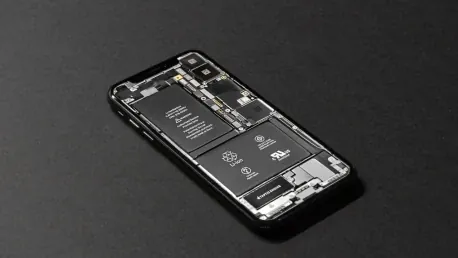The transformative advancements in smartphone battery technology have sparked significant excitement in the industry. Highlighted among these advancements are silicon-carbon batteries, a major innovation poised to revolutionize how smartphones are powered and charged. Traditionally, lithium-ion batteries have dominated the market due to their reliability, efficiency, and cost-effectiveness. However, these batteries face limitations such as diminished battery life over time and the challenge of balancing battery capacity with the sleek, slender designs of modern smartphones. Silicon-carbon batteries emerge as a game-changer capable of addressing these critical issues, promising users longer-lasting power in more compact and durable devices.
The Shift from Lithium-Ion to Silicon-Carbon Batteries
The Limitations of Lithium-Ion Batteries
Lithium-ion batteries have long been the go-to for smartphone manufacturers, largely due to their superior balance of cost, efficiency, and reliability. Despite their widespread use and proven track record, these batteries come with several significant drawbacks. One major issue is battery degradation, which leads to reduced battery life and diminished performance over time. Additionally, as modern smartphones continue to demand slimmer and more sophisticated designs, manufacturers often face challenges in balancing substantial battery capacity without compromising on the device’s form factor. This delicate balance frequently results in compromises on battery life, leaving consumers with shorter usage times and the need for frequent charging.
Moreover, lithium-ion batteries can struggle with thermal management. Prolonged or intensive usage can cause these batteries to overheat, which not only affects performance but also raises safety concerns. The chemical composition of lithium-ion batteries also poses challenges in terms of environmental impact, as the extraction and disposal of lithium are not environmentally friendly. As consumer expectations for longer-lasting, faster-charging, and more eco-friendly batteries grow, the inherent limitations of lithium-ion technology become increasingly apparent.
The Role of the Anode in Battery Performance
The anode, an essential component where energy storage and release occur during charging cycles, plays a critical role in battery performance. Traditional lithium-ion batteries use graphite anodes, which limit energy density and, consequently, the overall capacity of the battery. Silicon-carbon batteries, however, replace graphite with silicon-infused anodes, offering a significant improvement in energy storage capacity. The key advantage of silicon lies in its ability to store up to ten times more energy than graphite, resulting in higher energy density and the potential for more power within the same physical space.
Silicon, despite its advantages, presents challenges due to its propensity to expand and contract during charging cycles, potentially leading to structural damage and reduced longevity. To mitigate these issues, manufacturers have developed silicon-carbon batteries by infusing silicon with carbon. This approach enhances durability and stability while maintaining the high energy density afforded by silicon. The combination of silicon and carbon creates a more resilient material that can withstand the stresses of repeated charging cycles without compromising capacity or performance. This innovative design marks a significant leap forward in battery technology, addressing the limitations of traditional graphite anodes and paving the way for more efficient and powerful batteries.
Advantages of Silicon-Carbon Batteries
Higher Energy Density and Power
One of the most striking advantages of silicon-carbon batteries is their higher energy density, which allows for substantially more power to be packed into the same space compared to traditional lithium-ion batteries. Silicon, as an anode material, can store up to ten times more energy than graphite, translating into smartphones with larger batteries exceeding 6,000mAh without adding bulk to the device. This increased energy density means that users can enjoy longer usage times and require fewer charging sessions, significantly enhancing the overall user experience.
The higher energy density also enables manufacturers to design sleeker and more lightweight devices without sacrificing battery life. Consumers can benefit from advanced smartphones that integrate cutting-edge technology and larger screens while still maintaining portability and convenience. As the demand for high-performance devices continues to grow, the ability to offer substantial power in compact and aesthetically pleasing designs becomes a crucial differentiator in the competitive smartphone market. The shift to silicon-carbon batteries thus meets the evolving needs of consumers who expect both power and elegance in their devices.
Faster Charging Speeds
Another remarkable advantage of silicon-carbon batteries is their ability to support higher wattages, which translates into ultra-fast charging capabilities. Unlike traditional lithium-ion batteries, which often require several hours to recharge fully, silicon-carbon batteries can be recharged within minutes. This rapid charging capability offers users the convenience of quick top-ups, significantly reducing downtime and ensuring that their devices are always ready for use.
The ability to charge a smartphone rapidly is a game-changer for users who rely heavily on their devices for both personal and professional tasks throughout the day. Fast charging can mitigate the inconveniences associated with low battery levels, allowing users to regain several hours of usage in just a few minutes of charging. This advancement is particularly valuable in today’s fast-paced world, where connectivity and accessibility are paramount. The integration of ultra-fast charging technology in smartphones not only enhances the user experience but also provides a competitive edge for manufacturers who leverage silicon-carbon batteries in their products.
Improved Long-Term Durability
Silicon-carbon batteries also boast improved long-term durability compared to their lithium-ion counterparts. These batteries degrade at a much slower pace, ensuring that smartphones maintain their battery life over extended periods. The enhanced durability provided by silicon-carbon technology translates into a prolonged overall lifespan for devices, offering better value for consumers and reducing the need for frequent battery replacements.
The slower degradation rate of silicon-carbon batteries stems from the stability afforded by the combination of silicon and carbon. This composition effectively mitigates the wear and tear associated with repeated charging cycles, preserving battery performance and capacity over time. As a result, users can enjoy consistent, reliable battery life long after the initial purchase, addressing a common frustration with traditional lithium-ion batteries. For consumers, the improved longevity and stability of silicon-carbon batteries provide a compelling reason to invest in next-generation smartphones equipped with this advanced technology.
Implementation in Flagship Smartphones
Chinese Brands Leading the Charge
Chinese smartphone manufacturers have emerged as leaders in the integration of silicon-carbon batteries into their latest flagship devices. Brands such as Realme, iQOO, OnePlus, OPPO, Vivo, and Xiaomi are at the forefront of this technological revolution, demonstrating the significant improvements that silicon-carbon batteries bring in terms of both battery capacity and charging efficiency. For instance, the Realme GT7 Pro features a 6,500mAh battery paired with 120W charging speed, a combination that promises prolonged usage and rapid recharging.
Other notable examples include the iQOO 13, which boasts a 6,150mAh battery, and the OnePlus 13, equipped with a 6,000mAh battery offering 100W wired and 50W wireless charging capabilities. These advanced features not only highlight the impressive power and longevity of silicon-carbon batteries but also underscore the competitive advantage held by manufacturers who adopt this technology. Consumers looking for cutting-edge performance and convenience in their smartphones are increasingly gravitating toward these brands, which continue to set new benchmarks in battery innovation.
The Lag of Industry Giants
Despite the impressive strides made by Chinese manufacturers, the two leading smartphone giants, Samsung and Apple, have not yet embraced silicon-carbon battery technology in their flagship models. Anticipated releases such as Samsung’s Galaxy S25 series and Apple’s iPhone 17 series have garnered attention, but they lack the cutting-edge battery features already being offered by their Chinese counterparts. This reluctance or delay to adopt the latest battery innovations could potentially impact their competitive edge within the market.
Samsung, a dominant force in the Android market, risks falling behind as competitors like Realme, OPPO, and Xiaomi continue to push the boundaries of battery performance and charging speeds. Similarly, while Apple has a fiercely loyal user base and a reputation for methodical innovation, the rapid advancements made by its competitors in battery technology may necessitate a quicker pace of innovation to maintain its market position. The evolving landscape of battery technology underscores the need for established industry leaders to stay agile and responsive to emerging trends, ensuring that their flagship products remain competitive and appealing to discerning consumers.
Consumer Benefits and Market Impact
Enhanced User Experience
The increased competition in the smartphone market driven by silicon-carbon battery technology ultimately serves to benefit the consumer. As companies like Realme and Xiaomi push the envelope with advanced battery features, they exert pressure on industry giants such as Samsung and Apple to innovate and enhance their offerings. This dynamic competition drives technological advancements, resulting in better products with faster charging, longer battery life, and sleeker designs.
Consumers stand to gain from this continuous cycle of innovation, as manufacturers strive to outdo each other in delivering superior user experiences. With longer-lasting batteries that charge more quickly and devices that maintain their performance over an extended lifespan, users can enjoy more reliable and efficient smartphones. The ongoing improvements in battery technology ensure that users do not have to compromise on device aesthetics or functionality, leading to a more satisfying and seamless interaction with their devices. The benefits of silicon-carbon battery technology thus extend beyond power and durability, enhancing the overall quality and enjoyment of the smartphone experience.
The Future of Smartphone Batteries
The transformative advancements in smartphone battery technology have generated considerable excitement in the industry. One of the most notable innovations is the development of silicon-carbon batteries, which are set to revolutionize how smartphones are powered and charged. Historically, lithium-ion batteries have dominated the market due to their reliability, efficiency, and affordability. However, these batteries have notable limitations, such as reduced battery life over time and the difficulty of balancing battery capacity with the slim, sleek designs of modern smartphones. Silicon-carbon batteries, on the other hand, present a groundbreaking solution to these critical limitations. They offer significantly longer-lasting power while allowing for more compact and durable devices. This revolutionary technology addresses the persistent challenge of battery degradation and provides a more sustainable power source for the ever-evolving smartphone market. With the advent of silicon-carbon batteries, users can look forward to an enhanced and extended smartphone experience, marking a significant leap forward in mobile technology.









